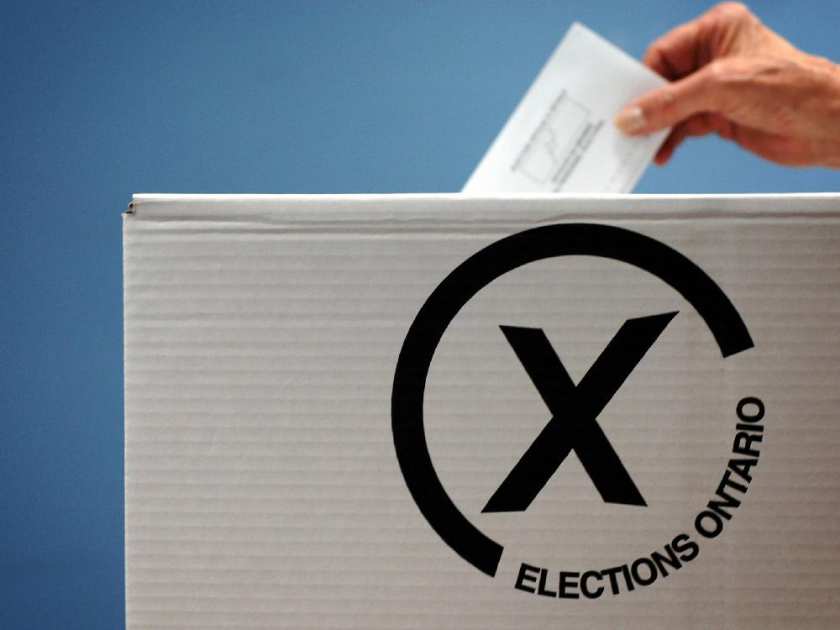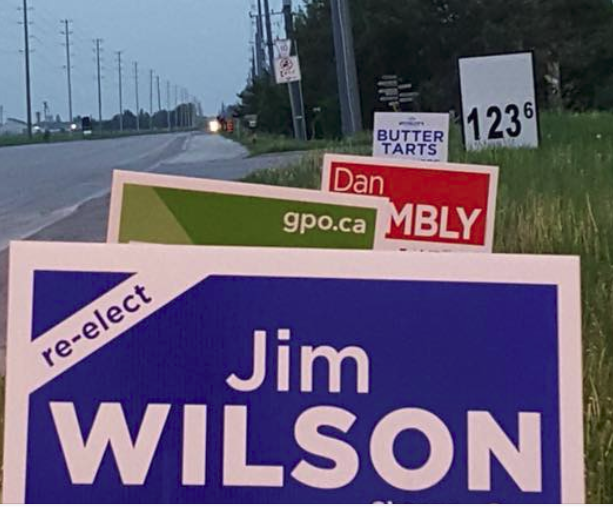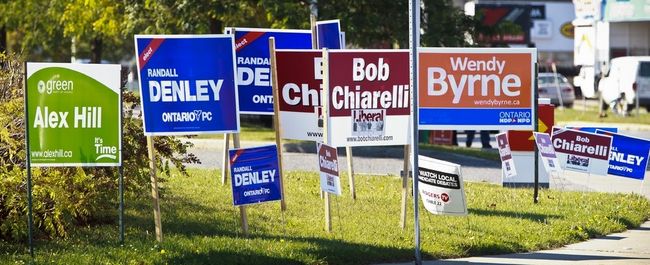 By Staff
By Staff
June 12th, 2018
BURLINGTON, ON
PC Party of Ontario won 76 seats, got 2,322,422 votes which was 40.49% of the votes cast.
Ontario NDP won 40 seats, got 1,925,574 votes which was 33.57% of the votes cast.
Ontario Liberal Party won 7 seats, got 1,123,283 votes which was 19.59% of the votes cast.
Green Party of Ontario won 1 seat, got 263,987 votes which was 4.60% of the votes cast.
The Progressive Conservative party forms the government and will rule the province for the next four years.
Many want to see some form of proportional representation but that isn’t going to happen within the next four years.
The voting public was asked who they wanted to lead the province and while it wasn’t a majority the votes the PC’s got were in the right places and that gave them the most seats in the Legislature.

Of the 9,888,888 Registered Electors on Lists; 58% of them turned out to vote.
There were 29 political parties looking for votes.

One political wag looked at these signs and said he chose the butter tarts.
Libertarian party got 42,918 votes
None of the Above Direct
Democracy Party got 16,186 votes.
INDEPENDENT party got 8644 votes.
Trillium Party got 8,178 votes.
N O P party got 5,802 votes.
Consensus Ontario got 2,684 votes
Freedom Party of Ontario got 2,567 votes.
Ontario Party got 2,310 votes.
Ontario Moderate Party got 2,191 votes.
Communist party got 1,471 votes.
CCP party got 1,234 votes
Stop the New Sex-Ed Agenda party got 1,078 votes
Alliance party got 804 votes.
The New People’s Choice Party of Ontario got 633 votes.
Party for People with Special Needs got 631 votes.
The People party got 626 votes.
Ontario Provincial Confederation of Regions Party got 385 votes.
Stop Climate Change party got 342 votes
Go Vegan got 256 votes.
SRP party got 238 votes.
CAP party got 215 votes.
P.O.T. party got 212 votes.
Multicultural Party of Ontario party got 191 votes.
CEP party got 151 votes
Paupers party got 111 votes.
There were 9,888,888 Registered Electors on Lists; 58% of them turned out to vote.

It appeared as if there were fewer election signs on the lawns in Burlington. Are the signs useful, do they serve a purpose ? They are not cheap and they eat up a lot of manpower.




















There is an excellent article describing the various electoral systems. It discusses the pros and cons of First Past the Post (FPTP), Alternative Vote (AV), List Proportional Representation (PR), Mixed-member Proportional representation (MMP), and Single Transferable Vote (STV). https://www.samaracanada.com/samara-in-the-classroom/electoral-reform/introduction/
For a somewhat theoretical discussion of the problems with various voting systems, see
https://plus.maths.org/content/which-voting-system-best
While I have always been in favour of some form of proportional representation, I am afraid it is impossible to implement in practice in our current political environment. First, mathematical analysis has shown that each and every one of the many proposed systems can produce an unexpected result, so getting people to decide on the PR method is controversial. More importantly though, PR assumes cooperation for the greatest good. The present culture of rabid partisan party loyalty focused only on power (combined with the sheer apathy of half the eligible voters) would ensure only permanent gridlock. It only works in progressive cultures of which, right now, ours is not.
Before we “throw the baby out with the bath water” let’s be absolutely sure we know what we are signing up for before we wholeheartedly embrace proportional representation.
New Zealand adopted proportional representation a few years ago. The results have been mixed. Yes…there is better representation for aboriginal groups. However, in a recent article even the former Prime Minister, Jim Bolger, admitted it wasn’t such a great idea. But what is more worrisome has been the rise in Europe of extremist right-wing political parties. Both the Netherlands and Austria have proportional representation in their election systems, and the rise of extremist right wing political parties has been truly worrisome:
https://thetyee.ca/Opinion/2017/11/10/How-Proportional-Representation-Empowers-the-Far-Right/
First past the post isn’t perfect, but at least we don’t have to contend with “spaghetti Parliaments” as in Italy which staggers from one short-lived coalition government to another. We also don’t have to continually pander to small, fundamentalist religious groups which is the norm in Israel. If political stability is the price we have to pay for not having proportional representation let me know where I send my cheque.
I would rather we focus attention on how to engage the public meaningfully in the formulation of public policy between elections rather than fixating on what comes out the back end every four years.
There were 2,998,740 ineffective votes (went towards electing no-one)
There were 2,736,190 effective votes (elected someone, not necessarily P.C.)
It only took 1,741,320 votes to elect 76 Conservatives and give them 100% of the power. In other words, only 17% of the eligible votes gave the new government 100% of the power.
I can see why people think their vote doesn’t count. We need proportional representation now.